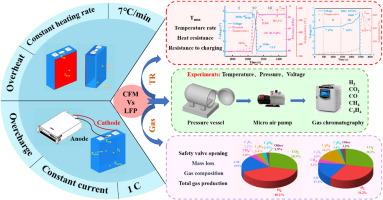Thermal runaway behavior of large-format sodium-ion and lithium-iron phosphate batteries under different trigger sources: A comparative study
IF 17
1区 工程技术
Q1 ENERGY & FUELS
引用次数: 0
Abstract
Sodium-ion batteries (SIBs) have emerged as a promising complementary technology to lithium-ion batteries (LIBs), primarily due to their potential for cost-effectiveness and resource sustainability. However, the thermal safety of SIBs still needs to be evaluated, as it is crucial for their potential application in electric vehicles and energy storage fields. In this study, we systematically examine and compare the thermal runaway (TR) and gas venting behaviors of 185 Ah Cu-Fe-Mn-based sodium-ion (CFM) and 314 Ah LiFePO4 (LFP) batteries under overcharging and overheating conditions-factors. Experimental results indicate that the TR process in CFM batteries exhibits distinct characteristics when compared to LFP batteries. Under overcharging conditions, CFM batteries experience more severe temperature fluctuations than those observed during overheating-maximum TR temperatures reach 620.9 °C and 587.3 °C, respectively-significantly higher than those recorded in LFP batteries. The activation time of the safety valve is similar to the onset of TR in both scenarios. Gas analysis reveals that the primary gaseous compositions generated during TR in CFM batteries are comparable to those produced by LFP batteries, with total gas volumes measuring 397.6 L during overheating and 699.3 L during overcharging. Although CFM batteries demonstrate superior resistance to overcharging relative to LFP counterparts, their elevated TR temperatures coupled with substantial emissions of combustible gases-including hydrogen, carbon monoxide, and methane considerably heighten combustion and explosion risks. These results may contribute to safer integration of CFM batteries in future applications, such as in electric vehicles, charging station and energy storage systems.

不同触发源下大规格钠离子电池和磷酸铁锂电池热失控行为的比较研究
钠离子电池(sib)已经成为锂离子电池(lib)的一种有前途的补充技术,主要是因为它们具有成本效益和资源可持续性的潜力。然而,sib的热安全性仍然需要评估,因为它对于其在电动汽车和储能领域的潜在应用至关重要。在这项研究中,我们系统地研究和比较了185 Ah cu - fe - mn基钠离子(CFM)和314 Ah LiFePO4 (LFP)电池在过充和过热条件下的热失控(TR)和排气行为。实验结果表明,与LFP电池相比,CFM电池的TR过程具有明显的特点。在过充条件下,CFM电池的温度波动比过热时更严重,最高TR温度分别达到620.9°C和587.3°C,显著高于LFP电池。在两种情况下,安全阀的激活时间与TR的开始时间相似。气体分析表明,CFM电池在TR过程中产生的主要气体成分与LFP电池相当,过热时的总气体体积为397.6 L,过充时的总气体体积为699.3 L。尽管CFM电池相对于LFP电池具有更强的抗过充能力,但其较高的TR温度加上大量可燃气体(包括氢气、一氧化碳和甲烷)的排放大大增加了燃烧和爆炸的风险。这些结果可能有助于CFM电池在未来的应用中更安全的集成,例如电动汽车、充电站和储能系统。
本文章由计算机程序翻译,如有差异,请以英文原文为准。
求助全文
约1分钟内获得全文
求助全文
来源期刊

Etransportation
Engineering-Automotive Engineering
CiteScore
19.80
自引率
12.60%
发文量
57
审稿时长
39 days
期刊介绍:
eTransportation is a scholarly journal that aims to advance knowledge in the field of electric transportation. It focuses on all modes of transportation that utilize electricity as their primary source of energy, including electric vehicles, trains, ships, and aircraft. The journal covers all stages of research, development, and testing of new technologies, systems, and devices related to electrical transportation.
The journal welcomes the use of simulation and analysis tools at the system, transport, or device level. Its primary emphasis is on the study of the electrical and electronic aspects of transportation systems. However, it also considers research on mechanical parts or subsystems of vehicles if there is a clear interaction with electrical or electronic equipment.
Please note that this journal excludes other aspects such as sociological, political, regulatory, or environmental factors from its scope.
 求助内容:
求助内容: 应助结果提醒方式:
应助结果提醒方式:


